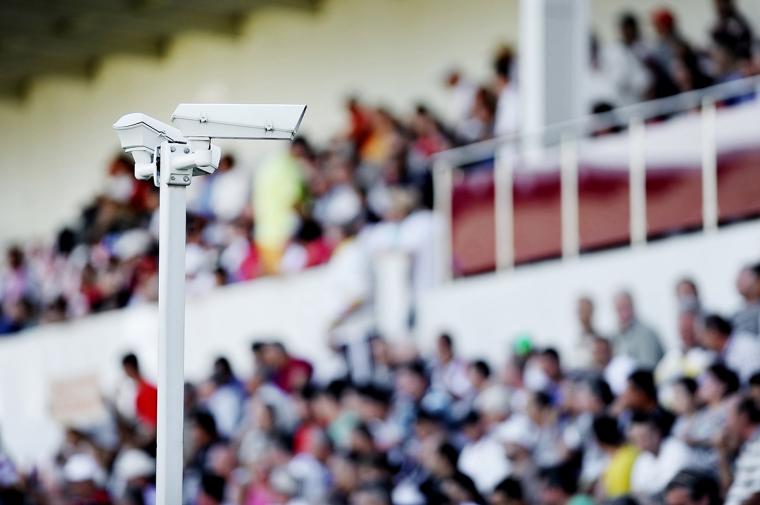
 Securing stadiums and arenas has gotten increasingly more difficult in the last decade, given the vast numbers and sources of potential threats. Security breaches not only put people, property and assets at risk, they create huge liabilities that can have long-lasting effects on operations and profitability.
Securing stadiums and arenas has gotten increasingly more difficult in the last decade, given the vast numbers and sources of potential threats. Security breaches not only put people, property and assets at risk, they create huge liabilities that can have long-lasting effects on operations and profitability.
Fortunately, the security industry has stepped up to the challenge with new and powerful solutions to help sports facility management provide safer and more secure sports and entertainment environments. Here are eight security technologies that are proving to be most effective:
1. Intelligent Video Management Systems
Intelligent Video Management Systems (VMS) with advanced analytics provide sports facilities with the ability to achieve situational awareness of large complexes including all internal and exterior locations. For example, new VMS solutions equipped with natively developed analytics from Intelligent Security Systems (ISS) provide security professionals with a powerful way to automatically detect and identify potential threats. These seamlessly integrated solutions employ Artificial Neural Network technology from Intel that allows multiple algorithms to simultaneously process information resulting in a higher form of Artificial Intelligence (AI) that have proven to be effective in numerous sports venues around the world.
Complex applications include facial recognition and license plate recognition for precise identification of people and vehicles; heat mapping and people counting to manage pedestrian traffic and maintain compliance; and under-vehicle surveillance systems (UVSS) to protect parking and loading areas. All of these intelligent applications can be deployed for any or all cameras installed in a facility enabling security management to maintain tighter controls.
2. Awareness and Response Collaboration System
Sports facilities present unique security and safety challenges because the majority of the attendees are visitors with a wide range of activities to monitor and detect. The best way to meet these dynamic security requirements is to provide a unique security solution that combines the machine intelligence of physical security systems with the human intelligence of a managed mobile communications system. The best example of this is a system combining otherwise disparate physical security, communications, business intelligence and data integration capabilities onto a single platform. These systems provide security and operations management with total situational awareness and better collaboration, allowing them to coordinate the activities of first responders and the people they are protecting with the information they need to know in the event of an emergency. In addition to dramatically improving overall safety and security, these systems increase users’ Return on Investment (ROI) with lower Total Cost of Ownership (TCO) by eliminating the need to rip and replace legacy systems and infrastructure.
3. Key Management System
A sports facility must serve a variety of purposes both on gameday and year-round, and as such, has many different security needs. A stadium needs multiple services provided in different areas of the arena, tiered accesses for VIPs, talent, vendors, staff, players, fans and others, and must facilitate the safe flow of large crowds. Effectively securing a stadium, while also giving appropriate access to persons who are authorized, is a massive undertaking that must be done correctly to avoid creating major security risks. Key control and asset management systems can help to ensure that the security of a stadium is efficiently and accurately managed.
Key management systems can manage tiered and varied accesses, which may change as different events take place or the stadium is utilized for different functions. Those with keys to the practice fields may be restricted from the concessions stands, and vice versa. A key control system can easily be configured and reconfigured by security personnel to give temporary access, such as for VIPs or talent, while maintaining security in the rest of the stadium by ensuring that staff with specific accesses are only granted access to those areas, even as other needs may change. In addition, two-factor authentication in place on key control systems can make it so that a second authorized person is required to access — and to return — individual keys, ensuring that they are not used to grant access to restricted areas later on.
4. Asset Management Solutions
As mobile devices become more prevalent in everyday life, so too are they used to make stadium operations — from on-field game plans to boardroom displays – more efficient. Small mobile devices, including tablets and laptops, unfortunately, are easily stolen. Radio Frequency Identification (RFID)-enabled asset management allows security to easily locate stored assets, keep a record of who has removed a device and from where, and have a notification sent to them when that device is placed in the system, on any locker in the system. RFID tags can be easily placed on essential assets and tagged, making it simple to securely store mobile devices and track their removal and replacement.
5. Safety and Visitor Management Systems
A modular, cloud-based visitor management system with built-in event management, watchlist screening, mobile alarms and emergency communication can be leveraged by sports venues to screen visitors at private events, and as a mobile alarm system during larger sporting events. Screening visitors can be as simple as scanning a state-issued ID.
Many visitor management systems cross-reference the visitor’s information against the national and internal watchlists nearly instantly. More advanced systems can even be used to notify personnel of the arrival of VIPs. Mobile alarm features included in some visitor management systems also empower every member of your staff to make a difference when seconds count. Mobile users can trigger silent alarms to notify select personnel of an emergency.
6. Revolving Doors and Security Barriers
At many sporting arenas, crowd control and unauthorized entry can be of great concern. One way to help combat those issues is by installing the proper security entrances. Tripod and full-height turnstiles have proven to be an ideal entry and exit security solution for many arenas. These rugged turnstiles effectively direct and regulate large volumes of pedestrian traffic through specific, guarded entry points for safe crowd control. Turnstiles require minimal training and can be overseen by security officers or other arena staff. Professionals at companies that manufacture security entrance solutions can help you tailor an entrance plan to the specific needs of your arena.
7. Surge Protection Systems
A power surge can be devastating to the safety of any sporting event, shutting down the ticketing, lighting, video surveillance and other systems required to keep events up and running, and safe for all patrons. The power onrush from surges across sensitive electronic systems and devices, such as ticketing systems or video surveillance cameras, can cause devastating damage all at once, or slowly over time to decrease reliability, leading to an unsafe situation inside of the arena. Surge protection solutions can protect all essential electronic devices with a relatively small investment and protect the arena from the potentially disastrous consequences of a security breach due to nonfunctioning equipment.
8. Automated System Assurance and Verification Solutions
While hardware solutions such as access control and video surveillance are a necessity for securing sports arenas and stadiums, they are only effective if all of the elements in these systems are operating properly. Solutions with automated verification ensure that your systems and connected products are always working properly to maintain immediate situational awareness and facilitate faster responses to potential threats.
With automated service assurance, the performance of physical security systems are also assessed and maintained at a high level – important when cameras are deployed throughout stadiums and arenas to monitor individuals in large crowds (and especially important if facial recognition is being used).
Stadiums are also key targets for hackers because of credit card information and other data being exchanged within the facility and third-party processors. Having automated service assurance provides users with cyber-hygiene and chain of custody to maintain a safe system, while ensuring evidence can be gathered to withstand legal challenges. Typically, these solutions can also provide metrics/reporting for a data-driven approach, as well as an IoT Tracker which can be used to manage specialized devices and security equipment using a single monitoring station – the ideal “single pane of glass.”
Combine any combination or all eight of these powerful solutions, and your sports facility will undoubtedly be a safer venue for everyone who enters the premises. SDM

